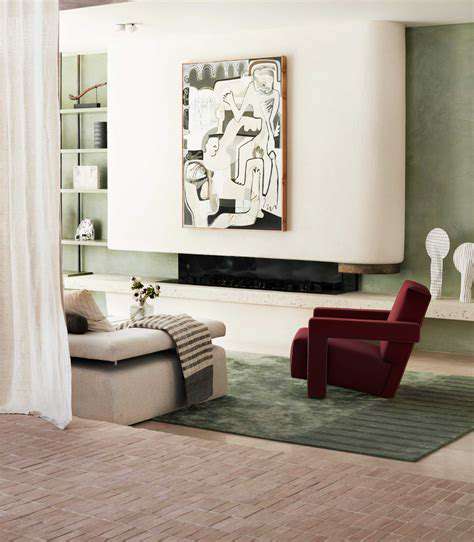The Impact of Door Design on Sleep Quality: Finding the Perfect Balance
How Door Materials Affect Sound Insulation

Understanding Sound Insulation Mechanisms
The materials used in door construction play a crucial role in their ability to insulate sound. Doors that are solid, such as those made from solid wood or composite materials, generally provide better soundproofing than hollow-core doors. This is due to the density and thickness of these materials, which absorb and deflect sound waves more effectively.
Incorporating sound-dampening materials within door cores can further enhance their acoustic performance. For instance, types of foam and mass-loaded vinyl can be used to reduce sound transmission, making a noticeable difference in noise levels between rooms.
Ultimately, understanding how different materials affect sound insulation can guide homeowners in selecting doors that not only match their aesthetic preferences but also enhance their sleeping environment by minimizing disruptive noise.
Comparing Different Door Materials
Wood, fiberglass, and steel are some of the most common materials used for doors. Each of these materials has unique properties that influence their soundproofing capabilities. Wood doors tend to be heavier and denser, which greatly contributes to their sound insulation properties.
Fiberglass doors offer lightweight durability and can be designed with acoustic features to improve insulation. However, they may not always match the soundproofing qualities of solid wood doors unless specifically engineered for that purpose.
Steel doors are popular for security, but they also provide good noise reduction, especially when combined with insulation techniques. When selecting a door, it's essential to consider not just the visual appeal but also how well it will perform in terms of sound insulation.
The Role of Door Design and Construction
The design and construction of a door can significantly impact its effectiveness in blocking sound. Features such as the sealing mechanisms, door frames, and even the quality of installation all contribute to the overall soundproofing. Gaps around the door can create channels for sound to enter, negating the benefits of a heavy door.
Weather stripping and soundproofing seals can enhance the door's ability to prevent noise leakage. Proper installation is equally critical; even the best materials won’t perform well with poor workmanship.
Investing in well-designed doors that incorporate these elements can lead to a quieter home, making it easier for residents to sleep through disturbances.
Noise Reduction Strategies Beyond Door Material
While door materials are vital, they are just one part of a broader strategy for noise reduction in a home. Windows, walls, and even flooring contribute to the overall sound environment, and addressing these can improve sleep quality significantly. Incorporating area rugs, curtains, and acoustic panels can complement a solid door’s sound insulation properties.
Some homeowners opt for additional soundproofing measures, such as adding a secondary door or using a door sweep for extra sealing against noise. This multi-faceted approach ensures a holistic improvement in sound isolation.
Knowledge about these strategies enables homeowners to create a comprehensive soundproofing plan, ensuring that they can enjoy a peaceful environment conducive to good sleep.
The Psychological Impact of Noise on Sleep
Research has shown that noise can significantly affect sleep quality, leading to long-term health implications. Chronic noise exposure can cause sleep disturbances, increasing stress and adversely affecting overall well-being. Understanding the psychological impacts of noise is essential for creating a conducive sleep environment.
Individuals may experience difficulty falling asleep or frequently waking during the night due to loud noises. The cumulative effect of insufficient sleep can lead to cognitive impairments and emotional stress, making it imperative to address noise pollution.
By investing in quality door designs and materials, individuals can take steps to minimize noise disturbances and promote a healthier, more restful sleep experience.
Color and Aesthetics: Creating a Calming Atmosphere

Understanding Color Psychology
Colors have a profound effect on our emotions and perceptions. Choosing the right color for your bedroom door can influence your overall mood and relaxation levels.
For instance, softer hues like blues and greens are known for their calming effects, while vibrant colors can stimulate energy and wakefulness.
Choosing the Right Materials
The materials used in door design also play a crucial role in aesthetics. Wood adds warmth and a natural feel, whereas metal might lend a more modern and minimalist look.
Additionally, incorporating sound-dampening materials can enhance the door's ability to block out unwanted noises, further contributing to a serene environment for sleep.
Innovative Design Features
Contemporary door designs often include innovative features like frosted glass panels or decorative elements. These not only enhance the visual appeal but also help maintain privacy.
Implementing such design features can create an inviting ambiance in the bedroom, making it a personal sanctuary for relaxation and comfort.
The Role of Lighting
Lighting can significantly affect how color is perceived. Soft, warm lighting around the door frame can enhance the calming colors you choose, creating a harmonious transition into your living space.
Strategically placed lighting can also highlight architectural details, adding a layer of sophistication to the overall design.
Personalization for Better Sleep
Personalizing your door design with elements that reflect your style can contribute to a sense of belonging and comfort. Incorporating artwork or meaningful decorations can create a nurturing environment that promotes better sleep.
Ultimately, the goal is to ensure that the door not only serves its functional purpose but also resonates with your aesthetic preferences, contributing to a restful sleep experience.
Door Placement and Design: Influencing Airflow and Light Control

Understanding Airflow Dynamics
The design of a door can greatly impact the airflow within a room. A well-placed door can promote better air circulation, leading to a more comfortable sleeping environment. Consider the positioning of the door relative to windows and vents, as this can either enhance or disrupt airflow. Optimizing airflow is crucial for ensuring that fresh air circulates while stale air is efficiently expelled from the sleeping area.
When evaluating door designs, materials also play a significant role. For instance, solid doors may reduce airflow compared to louvered doors, which have slats that allow for better ventilation. Choosing the right material for a door can influence both airflow and noise reduction, which are vital components for improving sleep quality. Proper consideration of these factors can lead to an environment that promotes restorative sleep.
Another important aspect of airflow is the use of door seals and sweeps. These components can help control drafts but may restrict airflow if not designed properly. It's essential to strike a balance between maintaining an airtight seal and allowing for adequate ventilation. Ensuring that doors complement the overall airflow strategy in a room will enhance sleeping conditions.
Lastly, the orientation of the door in relation to the room layout can drastically change the dynamics of airflow. A thoughtfully designed entry point can facilitate cross-ventilation, allowing for a continuous flow of fresh air. Ultimately, considering airflow dynamics during the door design process is crucial for creating a pleasant sleeping atmosphere.
Light Control Features
Light exposure is a significant factor influencing sleep quality, making door design an important consideration. Different types of doors, such as solid, glass-paneled, or those with window inserts, can affect how much light enters a room. A well-designed door can help block out unwanted light, improving the darkness needed for a restful sleep environment.
In addition to the type of door, treatments like blackout curtains or shades can play a vital role in light control. However, the integration of these treatments must be compatible with the door design to be effective. Choosing doors that work harmoniously with light-blocking features can enhance overall light management in the room.
Furthermore, the use of transom windows or sidelights can create an aesthetically pleasing design while still managing light. These features allow natural light to enter without compromising the benefits of darkness. It’s essential to explore different design options that provide the right balance of light and privacy for optimal sleep quality.
Ultimately, the approach to light control in door design must consider individual preferences as well. Some people may prefer a room filled with natural light during the day, while others may prioritize a darker atmosphere for sleeping. Understanding these personal preferences can guide the choice of door design, ensuring it meets the specific needs of the user.
Noisy Environments and Sound Insulation
Noise pollution is a common issue that can disturb sleep, making sound insulation a crucial aspect of door design. Doors designed with soundproofing materials can significantly reduce the amount of external noise entering a room. A well-insulated door can create a calmer environment, conducive to better sleep quality.
The effectiveness of sound insulation depends not only on the door material but also on the design and construction. Solid-core doors typically provide better sound dampening than hollow-core doors. Incorporating soundproofing technologies can make a substantial difference for light sleepers or those living in noisy urban areas.
Additionally, door seals and gaskets are critical for minimizing sound transmission. Installing high-quality weatherstrips can further enhance the door’s ability to keep noise out. This means that even during peak noise hours, individuals can enjoy uninterrupted rest if their doors are designed with sound insulation in mind.
Ultimately, balancing sound insulation features with aesthetic appeal is essential in creating a door design that caters to both comfort and visual preferences. Finding the right balance will ensure that the door enhances the overall sleeping experience.
Thermal Comfort and Energy Efficiency
The thermal performance of a door can greatly impact overall room comfort, especially during extreme temperatures. A well-insulated door helps maintain a stable temperature, minimizing drafts and heat loss. By choosing energy-efficient doors, one can significantly reduce heating and cooling costs.
Materials like fiberglass and steel offer better insulation properties than traditional wooden doors, making them ideal for energy efficiency. Incorporating thermal breaks in the door design can further enhance energy savings and interior comfort. Such innovations prevent the transfer of heat and cold, creating a cozier atmosphere in sleeping quarters.
In addition, the design of the door frame can contribute to thermal comfort. An airtight seal between the door and frame minimizes energy loss and prevents drafts from interrupting sleep. Ensuring proper installation and alignment of the door can enhance the effectiveness of thermal insulation.
Ultimately, selecting a door design that prioritizes thermal comfort will contribute to a more restful night’s sleep. Understanding the relationship between door design, energy efficiency, and indoor climate is vital for achieving optimal sleep quality.
Personalization and Aesthetic Appeal
Incorporating personal style into door design can enhance the overall ambiance of a bedroom. A door that resonates with an individual's aesthetic preference can create a more inviting and comfortable environment. Personalization is key to ensuring the space feels like a sanctuary for rest.
Various options are available, including colors, finishes, and designs that can be tailored to individual tastes. From sleek modern designs to classic rustic styles, the choices are endless. Choosing the right door can contribute significantly to the room’s vibe and encourage relaxation.
Moreover, decorative elements such as hardware and carvings can enhance the visual appeal. By carefully selecting these features, one can create a cohesive look that reflects their personality. A beautiful entry point adds character to the bedroom, creating a space where individuals want to spend time unwinding.
Ultimately, investing time in selecting a door that aligns with personal style can elevate the overall sleep experience. Personalized aesthetics not only enhance the visual aspect of the room but also promote tranquility and comfort, essential for quality sleep.
Security and Emotional Comfort
Understanding the Psychological Effects of Door Design
The design of a door can significantly influence a person's psychological state. A well-designed door can evoke a sense of safety and stability, while a poorly designed door can contribute to feelings of unease or anxiety. When selecting a door for a bedroom, it's essential to choose a style and material that not only fits the aesthetic of the room but also provides a sense of security and protection.
The color of a door can have psychological effects as well. For instance, softer colors like light blue or green may promote relaxation, making them ideal for spaces meant for sleep. In contrast, bold colors like red or bright yellow might evoke energy and could potentially disrupt a calm environment.
Moreover, the placement of a door in a room can affect how one feels within that space. A door facing the entrance can create a grounding presence, while doors that are tucked away may lend an air of privacy but can also make a person feel isolated. Thus, understanding the interplay between design and psychology is crucial for creating a restful environment.
Acoustic properties also play a role in how door design affects psychological comfort. Doors with higher soundproofing qualities can help in reducing outside noise, which can disturb sleep. In contrast, hollow-core doors may allow more noise disruption, leading to increased anxiety and stress, which can impede a good night’s rest.
Ultimately, it is essential to consider how a door’s design interacts with personal preferences and lifestyle requirements. Engaging with these factors can lead to a more holistic approach to achieving better sleep quality through thoughtful door design.
Practical Considerations for Door Selection
When selecting the perfect door for enhancing sleep quality, a few practical considerations come into play. First and foremost, material is crucial. Solid wood doors offer better sound insulation compared to hollow-core options, making them an excellent choice for those sensitive to noise disturbances during the night.
In addition to material, the style of the door should fit with the overall room decor while prioritizing functionality. For example, sliding doors can save space and provide a modern aesthetic, while traditional hinged doors may inspire a more classic feel. Each type of door has its own benefits and drawbacks that can impact both comfort and ease of use.
Another aspect to consider is the level of privacy a door affords. Depending on living situations – such as sharing a home with family or roommates – doors that lock securely can provide peace of mind, knowing that one has their own personal space. Enhancing privacy tends to lead to a more restful atmosphere, which is significant for sleep quality.
Additionally, the way in which a door opens can impact the flow of the room. Bi-fold or pocket doors can offer more versatile options for smaller bedrooms, as they can create a spacious feel without compromising on privacy when closed. This flexibility can dramatically enhance comfort levels within the space.
Lastly, aesthetics should never be ignored in the equation. A beautifully designed door that resonates with one’s personal style can elevate the overall vibe of the sleeping environment. This sense of connection to one’s space further promotes relaxation and the potential for restorative sleep.



